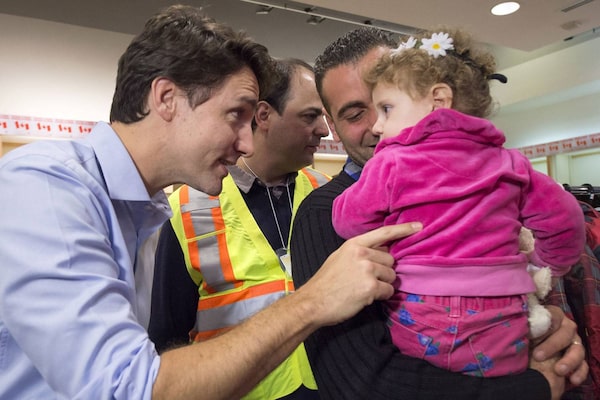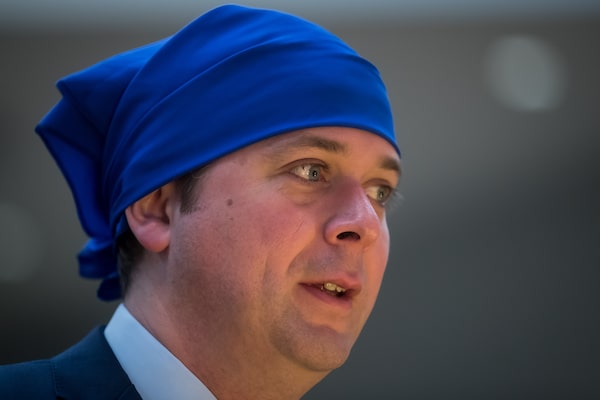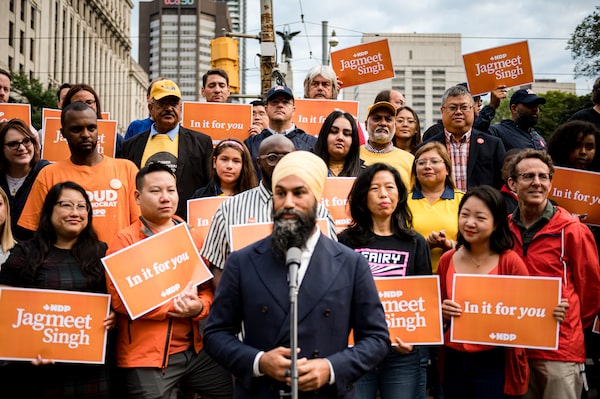
Muhammad Huzaifa Khalid, a Pakistani immigrant, takes the citizenship oath on Parliament Hill on April 17, 2019, at a ceremony marking the 37th anniversary of the Canadian Charter of Rights and Freedoms.Sean Kilpatrick/The Canadian Press
Table of contents • The issue, illustrated in charts • Liberals • Conservatives • New Democrats • Greens
The Canadian immigration debate has changed drastically since the 2015 federal election campaign, when Liberal Party Leader Justin Trudeau ran partly on a pledge to welcome 25,000 Syrian refugees. With the Syrian resettlement effort under way, the immigration file took an unexpected turn for the Trudeau government in 2017 when tens of thousands of asylum seekers started to flood across the Canada-U.S. border.
Initially, many of the border crossers were Haitians who had been living in the United States under a temporary protected status (TPS) they had been granted after the massive 2010 earthquake in Haiti. When the U.S. government announced its intention to end the TPS for Haitians, word spread among the community there that they could apply for refugee status in Canada if they headed north and found a way into the country.
Tens of thousands of asylum seekers from other countries, including Nigeria, Congo, Colombia and Turkey, have crossed into Canada since the loophole was widely exposed. Their reasons for fleeing to Canada are unclear.
They chose to avoid official border crossings out of fear they would automatically be turned back by border agents under the Canada-United States Safe Third Country Agreement, which requires both countries to refuse entry to most asylum seekers arriving from Canada or the U.S., as both countries are considered safe for refugees.
But there is a loophole in the agreement. Because it only applies at official points of entry, most asylum seekers who enter Canada through one of the unprotected stretches of the border can make a refugee claim here. More than 48,000 have since crossed into Canada at the border – most along the Quebec-New York stretch – and the matter has caused a great deal of friction. While the Conservatives have attacked the government for its “failure” to handle the situation, the government has accused the Tories of wanting to “militarize” the border.
The parties will also face questions about their broader plans for immigration during the campaign, including the number of newcomers the country needs to support the economy. Here’s what Canadians can expect from each of them.
The issue, illustrated and animated
What does the Safe Third Country Agreement between Canada and the U.S. actually say? Watch our video primer.
Liberals

Justin Trudeau visits Toronto's Pearson International Airport in December, 2015, to greet a family of refugees fleeing civil war in Syria.Nathan Denette/The Canadian Press
The Liberals have not released their platform yet, but if the past four years of government policy indicate anything, the party will likely focus on increasing immigration to Canada.
The Liberal government’s most recent plan sets a target of welcoming 350,000 immigrants by 2021, up from about 310,000 in 2018. The majority of new admissions will be set aside for economic immigrants, which Immigration Minister Ahmed Hussen says Canada needs to address skills shortages in the labour market.
Critics will be watching closely to see how the Liberals frame an issue that has dogged them: asylum seekers entering Canada through unauthorized border crossings.
The Liberals have tried to balance Canada’s legal obligation to allow them to seek protection at the border with alleviating the pressure the surge has put on the strained refugee system.
Earlier this year, the Liberals introduced a measure that prevents asylum seekers who have already made a claim in the U.S., Britain, Australia or New Zealand from getting a full refugee hearing by an independent tribunal in Canada.
Critics have said the Liberals were hypocritical for presenting Canada as a welcoming country while bringing in changes aimed at addressing the increase in asylum seekers at the border. Mr. Trudeau’s reputation as a proponent of diversity and multiculturalism was challenged this week when photos and video of him in blackface makeup surfaced. Mr. Trudeau has repeatedly apologized for the racist images, which date between the 1980s and 2001.
While the Conservatives will continue to call on Mr. Trudeau to do more to stem the flow, refugee advocates will look to the Liberal platform to keep Canada’s doors open to the world’s most vulnerable.
Conservatives

Conservative Party Leader Andrew Scheer bows his head before speaking at the Khalsa Diwan Society Sikh Temple during Vaisakhi celebrations this past April. Vaisakhi is a significant holiday on the Sikh calendar.Darryl Dyck/The Canadian Press
Although the Conservatives have not released their official platform, Leader Andrew Scheer outlined his party’s immigration plans during a major policy speech this year.
If elected, Mr. Scheer said a Conservative government would work to “immediately restore fairness, order and compassion in our immigration system.” He argued that Mr. Trudeau has undermined Canada’s immigration system by failing to stop the surge in asylum seekers at the Canada-U.S. border, causing significant backlogs in the refugee system.
The Conservatives say they would end the unauthorized border crossings by closing the loophole in the Safe Third Country Agreement – but that might be easier said than done.
The government has asked the U.S. to consider revamping the agreement so Canada can turn away more asylum seekers, but the U.S. has not agreed to reopen talks. In an interview with The Globe and Mail last month, Conservative immigration critic Michelle Rempel said a Scheer government would not take no for an answer from the Trump administration.
The Conservatives say they would prioritize the resettlement of “people facing true persecution," including genocide survivors, and do more to promote private sponsorship of refugees.
Although Mr. Scheer has said he would emphasize economic immigration to reflect what the economy needs, he has steered clear of saying how many newcomers Canada would welcome under his leadership. “That number may change every year, and I’m not going to get into a political debate or, worse, an auction about immigration numbers. The number will reflect what Canada needs and, just as importantly, who needs Canada," he said in his immigration policy speech in May.
New Democrats

NDP Leader Jagmeet Singh makes an announcement in Toronto on Sept. 2.Christopher Katsarov/The Canadian Press
“We know that immigrants strengthen our country and we will always stand against those who would use fear of our neighbours to divide us,” the NDP platform reads.
It says NDP Leader Jagmeet Singh would immediately suspend the Safe Third Country Agreement so asylum seekers in the U.S. could claim refugee status at official Canadian border crossings. Echoing refugee advocates, New Democrats argue the U.S. is not a safe country for refugees under the Trump administration’s immigration policies.
In terms of a bigger picture for immigration, the NDP says it would make sure the country’s immigration policies and levels meet its labour force needs, but it does not provide any numbers.
The party says it would also work with provinces to address gaps in settlement services and improve foreign credential recognition so newcomers can get to work in their fields.
The NDP says it would also take steps to address the waiting times for family reunification and end the “unfair” cap on applications to sponsor parents and grandparents.
Greens
The Green Party says immigration is key to solving the coming demographic imbalance, in which younger generations will support the growing population of older Canadians. The party platform does not set any goals for overall immigration numbers.
On border issues, the Greens say they would terminate the Safe Third Country Agreement with the United States altogether.
On refugees, the Greens say they would “lead a national discussion” to define the term “environmental refugee,” and establish it as a new category in Canada’s immigration system.
The Greens say they would eliminate the temporary foreign worker program and increase overall immigration, with a goal of making more of those people permanent residents. They would also work to make sure foreign professionals have an easier time establishing their credentials in Canada.